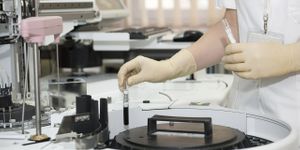Scientists Link Three Genes to Miscarriage
A miscarriage can be a devastating experience, and researchers are trying to learn more about genetic factors that may influence it. New work by investigators at the Research Institute of the McGill University Health Centre (RI-MUHC) and McGill University has revealed three genes that underlie a rare dysfunction called recurrent molar pregnancies, which happen when an embryo with a severe chromosomal abnormality grows and can implant into the uterus. This study will help broaden our very limited understanding of the genetic causes of miscarriage and can improve patient counseling. The research has been reported in The American Journal of Human Genetics (AJHG).
In the video above from this study, an oocyte is losing its chromosomes.
"Our findings add three new genes to the list of mutations leading to fetal loss and will allow for more DNA testing for patients in order to prevent the recurrence of molar pregnancies and provide better genetic counseling and management for couples," said lead study author Dr. Rima Slim, who is a researcher in the Child Health and Human Development (CHHD) Program at the RI-MUHC and an associate professor of Human Genetics and Obstetrics and Gynecology at McGill University.
Estimates vary on the frequency of molar pregnancy, which the March of Dimes suggests occurs in about one of every thousand pregnancies in the United States. In Quebec, it happens in around one of every 600 pregnancies. The chromosomes in a molar pregnancy all come from the father. In the instances where some placental tissue also grows, a cyst-like mass is eventually formed, and any growing embryo is not supplied with the right nutrients. In around 15 to 20 percent of those cases, the mass turns into a malignant type of cancer. Although molar pregnancies are the most common of all placental diseases, little is known about the causes.
"Human pregnancies with no embryos have fascinated and puzzled scientists in all civilizations since the time of Hippocrates," said Dr. Slim, who has studied molar pregnancies for over 15 years and is featured in the following video. "Our findings uncover, for the first time, a mechanism for the genesis of this abnormality and link the causal factors involved in recurrent molar pregnancies, miscarriages, and male and female infertility to mutations in three genes."
With the help of 68 patients who had suffered repeated miscarriages and molar pregnancies, the research team was able to find mutations in three relevant genes - MEI1, TOP6BL/C11orf80, and REC114.
Next, the team used mice to model the MEI1 mutation to learn more about the loss of the maternal chromosomes from the embryo. They tracked oocytes from mice without the MEI1 gene, finding that they conceived pregnancies with an abnormal number of maternal chromosomes. However, those pregnancies were not viable when they were implanted. In other oocytes from the MEI1-deficient animals, all of the chromosomes were lost before fertilization, but the empty eggs could still be fertilized.
"The mouse model was very important in producing [a] new understanding of how these abnormal pregnancies occur without maternal chromosomes," said study co-author Dr. Teruko Taketo, a researcher in the CHHD Program of the RI-MUHC.
"The painful experience of a fetal loss associated with the discovery of an abnormal pregnancy is often destabilizing and stressful for women," said Magali Breguet, nurse coordinator of the RMTQ. "This collaboration is a positive step forward for women who must undergo several months of medical monitoring and also live with the anxiety that their next pregnancy may also be a molar pregnancy.”
In the video above, a zygote (or fertilized egg) containing only paternal chromosomes (in blue) while all maternal chromosomes (in cyan) are in the polar body.
Sources: AAAS/Eurekalert! via McGill University, March of Dimes, AJHG








